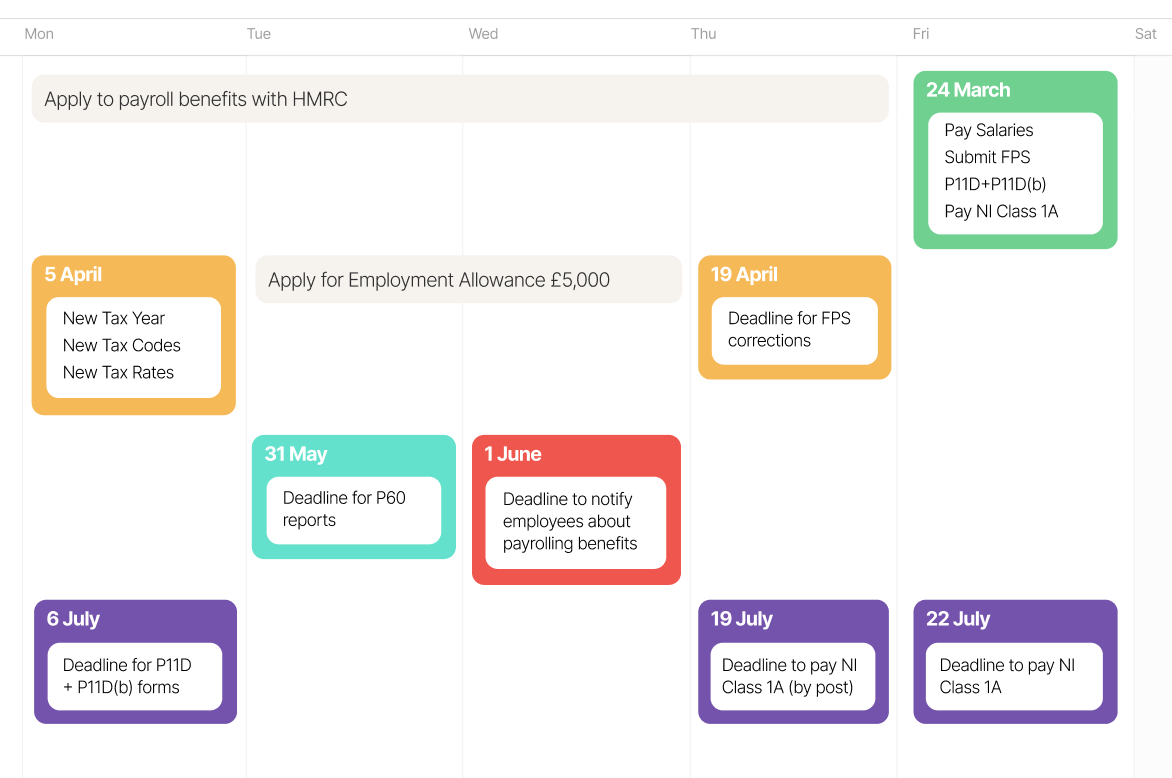With the new Tax Year 23/24 approaching, we have reviewed the most important changes and summarised all important steps for employers.

Closing Tax Year 2022/23
As well as running the last payroll for March, employers will need to take a few additional steps to report the state of their finances at the end of the tax year. Below you will find a summary of those steps as well as deadlines by which they must be completed.
Sending the last FPS
As usual, run your payroll and send the last Full Payments Submission (FPS) to HMRC on or before your employees’ last payday of the tax year (which ends on 5 April 2023). Make sure to mark it as the final for the year. Zelt does this automatically for you. Important: If you make any mistakes in the final submission you will have until 19 April to re-send the last FPS. After 19 April you will need to send a new FPS with the correct Year-to-Date values.
State any benefits with P11D form
Unless previously registered to payroll benefits through Real Time Information (RTI), employer needs to provide details of any benefits and facilities given for each of their employees with P11D form. The individual forms P11D are filled per employee who have had expenses and benefits. Employers have until 6 July each year to submit those forms. If the employer was registered to payroll benefits the taxable amounts will be reported in a full payment submission. Important: After you have submitted P11D – you will receive revised Tax Codes from HMRC for your employees who have been provided with any benefits to account for any unpaid tax from the previous tax year.
Pay class 1A National Insurance P11D(b)
You must pay Class 1A National Insurance contributions on work benefits you give to your employees, such as a Health Insurance or Rail tickets. The Class 1A National Insurance contributions liability applies if you’re payrolling the benefits or reporting to HMRC on form P11D. You must keep a record of benefits you give throughout the tax year so that you can accurately report and submit your P11D(b) and the Class 1A National Insurance contributions payment. This must be done by 6 July after the end of the tax year.You need to pay contributions on work benefits by 22 July each year for the previous tax year. You’ll need to pay by 19 July if paying by post.
Produce and share P60 with all current employees
Give a P60 to all employees on your payroll who are working for you on the last day of the tax year (5 April). The P60 summarises their total pay and deductions for the year. You must provide P60 reports to all employees by 31 May. In Zelt employees will be able to access their P60 reports as soon as the last payrun for the year is completed.
Starting the New Tax Year 23/24
Register for Payrolling Benefits
Payrolling benefits has a clear advantage for employees as they will pay tax on it evenly throughout the year. If you’re intending to payroll benefits and expenses, you must register them with HMRC using the payrolling employees taxable benefits and expenses service. You must do this before 5 April. You must still complete form P11D at the end of the tax year and mark each P11D ‘Payrolled’. This stops HMRC collecting tax that has already been deducted from your employees.
Employers must notify employees about any payrolled benefits by 1 June after the end of each tax year.
Review Employee Tax Information
At the start of the Tax Year your employee tax allowances will reset and its possible that some employees will receive a new Tax Code. Employers need to make sure the correct Tax Code is used. For existing employees check any HMRC notices. These would have been sent to you by post or in your Government Gateway online portal. And for any new joiners – ask them for a P45. Zelt will automatically save any changes provided by HMRC via Real Time Information (RTI) in employees’ profiles and any new joiners will be onboarded with their P45 provided or new starter checklist filled.
Employment Allowance
Apply for Employment Allowance, which allows eligible employers to reduce their annual National Insurance liability by up to £5,000 every tax year. You can do this in the Salary app settings in Zelt. You can apply if you’re a business or charity (including community amateur sports clubs) and your employers’ Class 1 National Insurance liabilities were less than £100,000 in the previous tax year. There is no strict deadline and it is possible to claim for the previous 4 years if you haven’t received this allowance before but were eligible for it.
Important tax dates
Important changes
Coming into play from your first payrun in the new Tax Year: April 2023 for Monthly and Week 14 for Weekly schedule.
National Minimum Wage increase
To account for inflation and the changing economy, the government has announced new NMW rates. These rates are for the National Living Wage (for those aged 23 and over) and the National Minimum Wage (for those of at least school-leaving age). The rates change on 1 April every year.
| Apprentice* | Under 18 | 18 to 20 | 21 to 22 | Over 23 |
| New Rate | £5.28 | £5.28 | £7.49 | £10.18 | £10.42 |
| Old Rate | £4.81 | £4.81 | £6.83 | £9.18 | £9.50 |
*Below 19 years old OR over 19 and are in their 1st year of apprenticeship
PAYE and National Insurance rates
The amount of Income Tax has largely remained the same but there were a few notable changes:
- The additional tax rate bracket has shifted to now 45% (47% in Scotland) on annual earnings above £125,140 (was £150,000 in 2022).
- Class 1 National Insurance Primary threshold returns to £12,570 per year (was fluctuating in 2022). For class A earnings above primary threshold will now be taxed at 12% (was 13.25% for the earlier part of the last tax year).
- Employer NI rates are 13.8% (was fluctuating between 13.8% to 15.05% in 2022).
New Statutory leave rates
Employers can claim back 92% of employees’ Statutory Pay. This number goes as high as 103% if your total Class 1 National Insurance for the previous tax year is £45,000 or lower.
| SMP | First 6 weeks: 90% of av weekly earnings. After 6 weeks: £172.48 (was £156.66 in 2022) or 90% of the employee’s average weekly earnings, whichever is lower |
| SPP | £172.48 (was £156.66 in 2022) or 90% of the employee’s average weekly earnings, whichever is lower |
| SAP | First 6 weeks: 90% of av weekly earnings. After 6 weeks: £172.48 (was £156.66 in 2022) or 90% of the employee’s average weekly earnings, whichever is lower |
| SSPP | £172.48 (was £156.66 in 2022) or 90% of the employee’s average weekly earnings, whichever is lower |
| SPBP | £172.48 (was £156.66 in 2022) or 90% of the employee’s average weekly earnings, whichever is lower |
| SSP | Paid daily, rates depend on the number of qualifying days in the week |
New Student Loan Deduction thresholds
Although the rate of deductions remains the same in the new tax year the thresholds for Plan 1 and 4 are changing:
Student loan deduction rates
- Student loan: 9%
- Postgraduate loan: 6%
Student loan thresholds
- Plan 1: £20,195 –> £22,015
- Plan 4: £25,375 –> £27,660